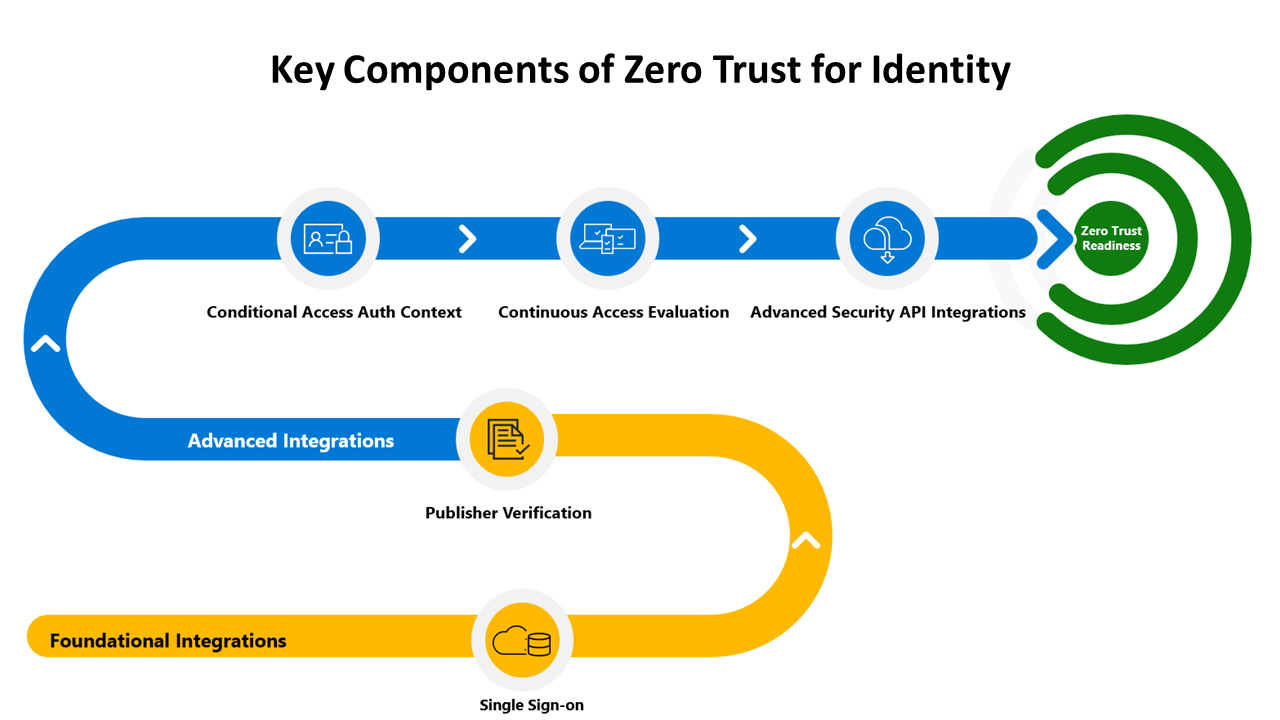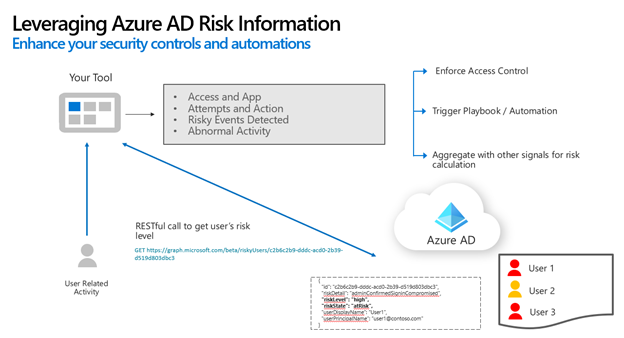Identity integrations
![]()
Identity is the key control plane for managing access in the modern workplace and is essential to implementing Zero Trust. Identity solutions support Zero Trust through strong authentication and access policies, least privileged access with granular permission and access, and controls and policies that manage access to secure resources and minimize the blast radius of attacks.
This integration guide explains how independent software vendors (ISVs) and technology partners can integrate with Microsoft Entra ID to create secure Zero Trust solutions for customers.
Zero Trust for Identity integration guide
This integration guide covers Microsoft Entra ID as well as Azure Active Directory B2C.
Microsoft Entra ID is Microsoft's cloud-based identity and access management service. It provides single sign-on authentication, conditional access, passwordless and multi-factor authentication, automated user provisioning and many more features that enable enterprises to protect and automate identity processes at scale.
Azure Active Directory B2C is a business-to-customer identity access management (CIAM) solution which customers use to implement secure white-label authentication solutions that scale easily and blend in with branded web and mobile application experiences. The integration guidance is available in the Azure Active Directory B2C section.
Microsoft Entra ID
There are many ways to integrate your solution with Microsoft Entra ID. Foundational integrations are about protecting your customers using Microsoft Entra ID's built-in security capabilities. Advanced integrations will take your solution one step further with enhanced security capabilities.
Foundational integrations
Foundational integrations protect your customers with Microsoft Entra ID's built-in security capabilities.
Enable single sign-on and publisher verification
To enable single sign-on, we recommend publishing your app in the app gallery. This will increase customer trust, because they know that your application has been validated as compatible with Microsoft Entra ID, and you can become a verified publisher so that customers are certain you are the publisher of the app they are adding to their tenant.
Publishing in the app gallery will make it easy for IT admins to integrate the solution into their tenant with automated app registration. Manual registrations are a common cause of support issues with applications. Adding your app to the gallery will avoid these issues with your app.
For mobile apps, we recommend you use the Microsoft Authentication Library and a system browser to implement single sign-on.
Integrate user provisioning
Managing identities and access for organizations with thousands of users is challenging. If your solution will be used by large organizations, consider synchronizing information about users and access between your application and Microsoft Entra ID. This helps keep user access consistent when changes occur.
SCIM (System for Cross-Domain Identity Management) is an open standard for exchanging user identity information. You can use the SCIM user management API to automatically provision users and groups between your application and Microsoft Entra ID.
Our tutorial on the subject, develop a SCIM endpoint for user provisioning to apps from Microsoft Entra ID, describes how to build a SCIM endpoint and integrate with the Microsoft Entra provisioning service.
Advanced integrations
Advanced integrations will increase the security of your application even further.
Conditional Access authentication context
Conditional Access authentication context allows apps to trigger policy enforcement when a user accesses sensitive data or actions, keeping users more productive and your sensitive resources secure.
Continuous access evaluation
Continuous access evaluation (CAE) allows access tokens to be revoked based on critical events and policy evaluation rather than relying on token expiry based on lifetime. For some resource APIs, because risk and policy are evaluated in real time, this can increase token lifetime up to 28 hours, which will make your application more resilient and performant.
Security APIs
In our experience, many independent software vendors have found these APIs to be particularly useful.
User and group APIs
If your application needs to make updates to the users and groups in the tenant, you can use the user and group APIs through Microsoft Graph to write back to the Microsoft Entra tenant. You can read more about using the API in the Microsoft Graph REST API v1.0 reference and the reference documentation for the user resource type
Conditional Access API
Conditional access is a key part of Zero Trust because it helps to ensure the right user has the right access to the right resources. Enabling Conditional Access allows Microsoft Entra ID to make access decision based on computed risk and pre-configured policies.
Independent software vendors can take advantage of conditional access by surfacing the option to apply conditional access policies when relevant. For example, if a user is especially risky, you can suggest the customer enable Conditional Access for that user through your UI, and programmatically enable it in Microsoft Entra ID.
For more, check out the configure conditional access policies using the Microsoft Graph API sample on GitHub.
Confirm compromise and risky user APIs
Sometimes independent software vendors may become aware of compromise that is outside of the scope of Microsoft Entra ID. For any security event, especially those including account compromise, Microsoft and the independent software vendor can collaborate by sharing information from both parties. The confirm compromise API allows you to set a targeted user’s risk level to high. This lets Microsoft Entra ID respond appropriately, for example by requiring the user to reauthenticate or by restricting their access to sensitive data.
Going in the other direction, Microsoft Entra ID continually evaluates user risk based on various signals and machine learning. The Risky User API provides programmatic access to all at-risk users in the app’s Microsoft Entra tenant. Independent software vendors can make use of this API to ensure they are handling users appropriately to their current level of risk. riskyUser resource type.
Unique product scenarios
The following guidance is for independent software vendors who offer specific kinds of solutions.
Secure hybrid access integrations Many business applications were created to work inside of a protected corporate network, and some of these applications make use of legacy authentication methods. As companies look to build a Zero Trust strategy and support hybrid and cloud-first work environments, they need solutions that connect apps to Microsoft Entra ID and provide modern authentication solutions for legacy applications. Use this guide to create solutions that provide modern cloud authentication for legacy on-premises applications.
Become a Microsoft-compatible FIDO2 security key vendor FIDO2 security keys can replace weak credentials with strong hardware-backed public/private-key credentials which cannot be reused, replayed, or shared across services. You can become a Microsoft-compatible FIDO2 security key vendor by following the process in this document.
Azure Active Directory B2C
Azure Active Directory B2C is a customer identity and access management (CIAM) solution capable of supporting millions of users and billions of authentications per day. It is a white-label authentication solution that enables user experiences which blend with branded web and mobile applications.
As with Microsoft Entra ID, partners can integrate with Azure Active Directory B2C by using Microsoft Graph and key security APIs such as the Conditional Access, confirm compromise, and risky user APIs. You can read more about those integrations in the Microsoft Entra ID section above.
This section includes several other integration opportunities independent software vendor partners can support.
Note
We highly recommend customers using Azure Active Directory B2C (and solutions that are integrated with it) activate Identity Protection and Conditional Access in Azure Active Directory B2C.
Integrate with RESTful endpoints
Independent software vendors can integrate their solutions via RESTful endpoints to enable multi-factor authentication (MFA) and role-based access control (RBAC), enable identity verification and proofing, improve security with bot detection and fraud protection, and meet Payment Services Directive 2 (PSD2) Secure Customer Authentication (SCA) requirements.
We have guidance on how to use our RESTful endpoints as well as detailed sample walkthroughs of partners who have integrated using the RESTful APIs:
- Identity verification and proofing, which enables customers to verify the identity of their end users
- Role-based access control, which enables granular access control to end users
- Secure hybrid access to on-premises application, which enables end users to access on-premises and legacy applications with modern authentication protocols
- Fraud protection, which enables customers to protect their applications and end users from fraudulent login attempts and bot attacks
Web application firewall
Web Application Firewall (WAF) provides centralized protection for web applications from common exploits and vulnerabilities. Azure Active Directory B2C enables independent software vendors to integrate their WAF service such that all traffic to Azure Active Directory B2C custom domains (for example, login.contoso.com) always pass through the WAF service, providing an additional layer of security.
Implementing a WAF solution requires that you configure Azure Active Directory B2C custom domains. You can read how to do this in our tutorial on enabling custom domains. You can also see existing partners who have created WAF solutions that integrate with Azure Active Directory B2C.
Next steps
Feedback
Coming soon: Throughout 2024 we will be phasing out GitHub Issues as the feedback mechanism for content and replacing it with a new feedback system. For more information see: https://aka.ms/ContentUserFeedback.
Submit and view feedback for



